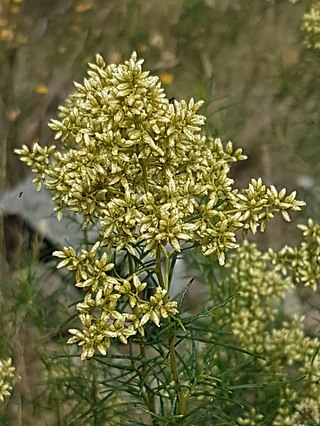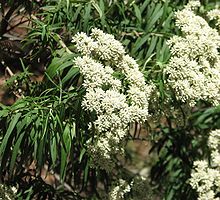
Cassinia tenuifolia, commonly known as bully bush or killmoke, is a species of flowering plant in the family Asteraceae and is endemic to Lord Howe Island. It is a dense, bushy shrub with hairy young stems, crowded linear leaves and sweetly scented flower heads arranged in corymbs.

Cassinia aureonitens, commonly known as the yellow cassinia is a species of flowering plant in the family Asteraceae and is endemic to eastern New South Wales. It is a shrub with elliptic leaves and heads of yellow flowers arranged in dense corymbs.

Cassinia compacta is a species of flowering plant in the family Asteraceae and is endemic to eastern Australia. It is a shrub with densely hairy stems, linear leaves and heads of yellow flowers arranged in dense corymbs.

Cassinia leptocephala is a species of flowering plant in the family Asteraceae and is endemic to New South Wales. It is a large, woody shrub with hairy, reddish stems, stiff linear leaves, and heads of pale yellow flowers arranged in a dense corymb.

Cassinia quinquefaria is a species of flowering plant in the family Asteraceae and is endemic to eastern Australia. It is a shrub with sticky, hairy foliage, linear leaves, and heads of creamy-white flowers arranged in a dense panicle.

Cassinia longifolia, commonly known as shiny cassinia, is a species of flowering plant in the family Asteraceae and is endemic to eastern Australia. It is an erect, aromatic shrub with sticky, hairy foliage, linear or oblong to narrow lance-shaped leaves, and heads of creamy-white flowers arranged in a dense corymb.
Cassinia copensis is a species of flowering plant in the family Asteraceae and is endemic to eastern Australia. It is an erect, multi-stemmed shrub with aromatic, cylindrical leaves, and heads of creamy-white flowers arranged in a flattened corymb.
Cassinia hewsoniae is a species of flowering plant in the family Asteraceae and is native to New South Wales and the Australian Capital Territory. It is an erect shrub with a sticky, densely-hairy stems, needle-shaped leaves and flower heads arranged in flat or rounded corymbs.
Cassinia maritima commonly known as coast cassinia, is a species of flowering plant in the family Asteraceae and is endemic to coastal areas of south-eastern Australia. It is an erect shrub with glandular hairs embedded in a sticky layer on its branches and leaves, needle-shaped leaves, and white to yellowish heads of flowers arranged in a flat-topped corymb.
Cassinia monticola commonly known as mountain cassinia, is a species of flowering plant in the family Asteraceae and is endemic to mountain areas of south-eastern Australia. It is a spreading shrub with sticky, narrow linear to narrow lance-shaped leaves, and bronze-coloured to greenish-cream heads of flowers arranged in a dense, round-topped corymb.
Cassinia ochracea is a species of flowering plant in the family Asteraceae and is endemic to south-eastern New South Wales. It is an erect or spreading shrub with hairy stems, needle-shaped leaves and flat or rounded corymbs of up to four hundred flower heads.
Cassinia straminea is a species of flowering plant in the family Asteraceae and is endemic to eastern Australia. It is an erect shrub with hairy young stems, linear leaves and corymbs of up to several hundred flower heads.

Cassinia lepschii is a species of flowering plant in the family Asteraceae and is endemic to eastern Australia. It is an erect or spreading shrub with densely hairy young stems, needle-shaped leaves and flower heads arranged in flat or rounded corymbs.
Cassinia diminuta, commonly known as dwarf cassinia, is a species of flowering plant in the family Asteraceae and is endemic to Victoria in Australia. It is a small, erect, aromatic shrub with spreading, needle-shaped leaves that are covered with cottony hair on the underside, and corymbs of up to two hundred heads of flowers arranged in corymbs.
Cassinia complanata, commonly known as smooth cassinia, is a species of flowering plant in the family Asteraceae and is endemic to south-eastern Australia. It is a shrub with sticky, densely hairy stems, narrow linear to cylindrical leaves and heads of small flowers arranged in corymbs.
Cassinia nivalis commonly known as ochre cassinia, is a species of flowering plant in the family Asteraceae and is endemic to eastern Victoria, Australia. It is an erect shrub with hairy, deep reddish-purple branches, hairy, needle-shaped leaves, and cream-coloured to ochre heads of flowers arranged in a hemispherical corymb.
Cassinia ozothamnoides, commonly known as cottony haeckeria, is a species of flowering plant in the family Asteraceae and is endemic to Victoria, Australia. It is an erect shrub with hairy branchlets, linear leaves and corymbs of up to two hundred flower heads.
Cassinia rugata, commonly known as wrinkled dollybush, or wrinkled cassinia, is a species of flowering plant in the family Asteraceae and is endemic to south-eastern Australia. It is a spreading to erect shrub with hairy, slightly sticky branchlets, oblong to narrow elliptic leaves and corymbs of up to three hundred flower heads.

Cassinia scabrida commonly known as rough cassinia, is a species of flowering plant in the family Asteraceae and is endemic to forests with rocky granite outcrops in north-eastern Victoria, Australia. It is an erect shrub with hairy foliage, linear leaves, and large numbers of greenish-white heads of flowers arranged in dense corymbs.
Cassinia tegulata commonly known as avenue cassinia, is a species of flowering plant in the family Asteraceae and is endemic to a small area near the Victoria-South Australia border. It is a small to medium-sized shrub with hairy foliage, needle-shaped leaves, and dense heads of off-white to cream-coloured flowers arranged in corymbs.









